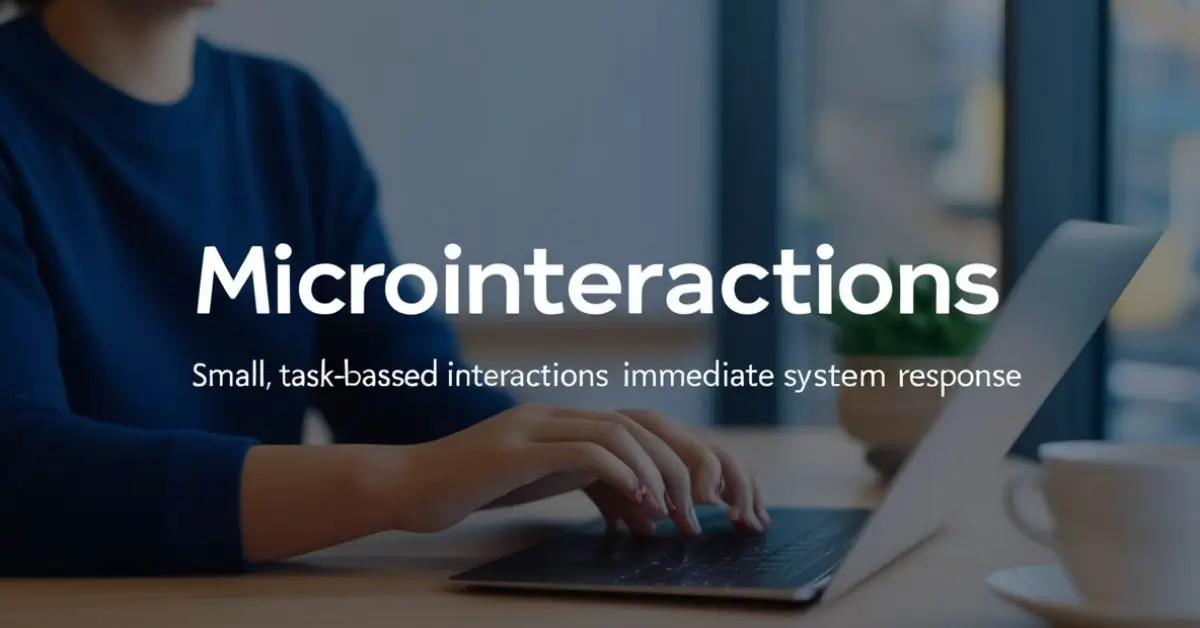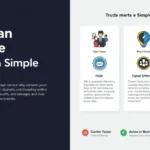Microinteractions are the subtle, almost invisible elements in user interfaces that guide, entertain, and inform users. They are small, focused interactions that revolve around a single task. From the sound of a notification to the animation when liking a post on social media, microinteractions have become a vital aspect of user experience (UX). As we move toward 2025, these microinteractions are evolving to play an even more integral role in shaping how we interact with digital platforms, apps, devices, and services.
In this article, we will explore the importance of microinteractions in the coming years, their growing influence on UX design, and the technological innovations driving their development. By understanding the trends and potential of microinteractions, businesses and designers can harness their power to improve user engagement, retention, and satisfaction.
What are Microinteractions?
Microinteractions are small, task-based interactions that are part of larger digital experiences. These typically involve a user action followed by an immediate system response. The essence of microinteractions lies in their simplicity—they are intended to be quick, almost unconscious, and delightfully engaging.
Examples of microinteractions include:
- Clicking a “like” button and seeing the animation or color change.
- A notification bell that shakes slightly when a new message is received.
- A success message after completing a form submission.
- A subtle vibration or haptic feedback when using touch devices.
While microinteractions may seem insignificant individually, collectively they contribute to a fluid and seamless user experience. They provide real-time feedback, clarify system status, enhance user satisfaction, and often add a touch of personality to digital products.
The Importance of Microinteractions in 2025
As we move toward 2025, the significance of microinteractions is expected to increase dramatically. With more advanced technologies, such as 5G, artificial intelligence (AI), and Internet of Things (IoT) devices, microinteractions will not only improve but will also become more complex and context-aware.
Enhancing User Engagement
User attention spans are shrinking. With countless apps and services vying for attention, a well-designed microinteraction can help capture a user’s interest and encourage continued engagement. These small moments of interaction give users positive feedback and subtly incentivize them to continue using the service. In 2025, microinteractions will evolve to be more personalized, with AI predicting user preferences and tailoring the experience accordingly.
Providing Instant Feedback
Microinteractions help users understand the results of their actions. Whether it’s showing a loading animation while a page is processing or indicating that a password entered is incorrect, microinteractions provide instant feedback that enhances the overall user experience. By 2025, this feedback will be smarter, contextual, and even predictive—making systems feel more intuitive.
Creating Brand Identity
Microinteractions can also reflect the identity and personality of a brand. Consider the playful animations that Facebook or Instagram uses when users interact with their platforms. These microinteractions create a sense of consistency and reinforce the brand’s voice. As more companies invest in personalized experiences, microinteractions will be a critical part of shaping a brand’s digital personality by 2025.
Technological Innovations Driving Microinteractions
The future of microinteractions will be shaped by several major technological innovations. These developments are already beginning to emerge and will define how users interact with digital systems in the next decade.
Artificial Intelligence and Machine Learning
In 2025, AI and machine learning will be essential for creating smart, context-aware microinteractions. By analyzing user behavior and preferences, AI can predict what a user might want to do next and offer microinteractions that guide them smoothly. These adaptive microinteractions can improve personalization and efficiency, making interfaces feel more natural and intuitive.
For instance, imagine an AI-powered interface that knows when you are trying to take a screenshot and offers a button to save or share the image automatically. Or, think of a microinteraction that suggests relevant options based on a user’s previous actions—speeding up tasks and reducing cognitive load.
Augmented Reality (AR) and Virtual Reality (VR)
With the rise of AR and VR, microinteractions will extend into immersive environments. In AR applications, users can interact with objects in the real world that are augmented with digital overlays. Microinteractions in these spaces might include hovering over an object to display additional information or swiping gestures to navigate through a virtual space. In VR, microinteractions will provide tactile feedback, guiding users through complex environments using natural and intuitive movements.
By 2025, AR and VR microinteractions will be more seamless and sophisticated, creating fully immersive experiences that blend the digital and physical worlds.
5G and Faster Connectivity
The arrival of 5G and faster internet speeds will open up new possibilities for real-time microinteractions. Low-latency networks will allow for immediate responses to user actions, enabling richer, more dynamic interactions. Whether it’s gaming, real-time collaboration, or accessing cloud-based services, microinteractions will feel more responsive than ever before.
In 2025, users will expect near-instantaneous feedback in all their digital interactions, and microinteractions will play a key role in delivering this expectation.
Voice-Activated Microinteractions
Voice interfaces are growing in popularity, with smart speakers and virtual assistants like Alexa and Siri leading the charge. In 2025, voice-activated microinteractions will become more commonplace, allowing users to complete tasks without having to look at or touch a screen. Whether it’s giving a command, asking a question, or making a purchase, microinteractions in voice-driven experiences will provide feedback through auditory cues, such as confirmation sounds or synthesized voice responses.
Haptic Feedback and Tactile Interfaces
Microinteractions have traditionally relied on visual and auditory feedback, but the growing use of haptic feedback (vibrations and physical sensations) will add another dimension. Wearables, smartphones, and other smart devices will use tactile microinteractions to give users subtle but valuable feedback. For example, a slight vibration could indicate that a user’s action was successful or alert them to a new notification without needing to look at a screen.
By 2025, haptic microinteractions will be more nuanced and contextually aware, providing users with richer sensory experiences across various devices.
Design Principles for Future Microinteractions
As microinteractions continue to evolve, designers must consider several key principles to ensure they create meaningful and effective interactions.
1. Simplicity and Clarity
Microinteractions should remain simple and to the point. They are designed to support users in completing specific tasks quickly. Overcomplicating a microinteraction with excessive animations or features can detract from its purpose and frustrate users. In 2025, the best microinteractions will be those that fade into the background, seamlessly guiding users through tasks without drawing unnecessary attention.
2. Personalization
With the rise of AI, personalization will be a central component of microinteractions in 2025. Designers must create interactions that adapt to individual user needs and preferences. Personalized microinteractions will help users feel more engaged, providing relevant information or prompts based on their previous behavior.
3. Context Awareness
Context is key to effective microinteractions. Designers must think about where, when, and how users will engage with the product. In 2025, context-aware microinteractions will be powered by AI, which will be able to predict user intent and provide the right interaction at the right time, reducing friction and enhancing usability.
4. Feedback Loops
One of the primary purposes of microinteractions is to provide feedback. By giving users instant confirmation of their actions, designers can help users understand what’s happening and what to expect next. This feedback should be clear and immediate, whether it’s through visual cues, sound, or haptic feedback.
5. Emotional Design
Microinteractions often add a playful or emotional element to digital experiences. Whether it’s a fun animation, a sound effect, or a clever visual cue, microinteractions can create moments of delight for users. As we approach 2025, emotional design will be even more important as brands look for ways to differentiate themselves and build emotional connections with their audience.
Future Trends for Microinteractions in 2025
Microinteractions will continue to evolve and expand as technology progresses. Here are a few future trends that will shape the design and implementation of microinteractions by 2025:
Hyper-Personalization
As AI becomes more advanced, microinteractions will be tailored not only to general user preferences but also to specific moods, habits, and even biometric data. For instance, wearable devices might trigger calming microinteractions when detecting stress, or provide fitness-related prompts based on physical activity data.
Ambient Interactions
Microinteractions will move beyond screens and devices to become ambient, blending into the environment around us. Smart homes, connected cars, and IoT devices will use microinteractions to offer feedback in the form of lighting changes, temperature adjustments, or sound alerts. These ambient interactions will be subtle yet effective in delivering real-time information.
Invisible Interactions
In the future, microinteractions may become almost invisible, driven by AI that understands user needs before they even take action. For example, an interface could automatically adjust itself based on a user’s previous actions, reducing the need for explicit commands. These invisible microinteractions will make digital systems feel more intuitive and effortless to use.
Conclusion
Microinteractions may be small in scale, but their impact on user experience is profound. As we move toward 2025, the role of microinteractions will only grow in importance as technological advances in AI, AR, 5G, and haptics take
center stage. These tiny, task-driven interactions will become smarter, more personalized, and more integrated into our everyday lives—helping us navigate digital experiences with ease and satisfaction.
By staying ahead of these trends and leveraging the latest innovations, designers can create microinteractions that captivate users, reinforce brand identity, and drive engagement. As the digital landscape evolves, those who embrace the power of microinteractions will be well-positioned to succeed in an increasingly connected and interactive world.











